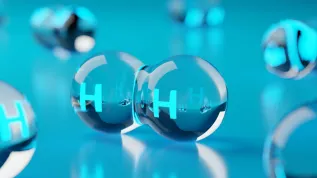
What do atomic nuclei really look like? Are the protons and neutrons they contain distributed chaotically, or do they bind into clumps made up of two protons and two neutrons? Polish physicists from Kraków and Kielce present predictions for several light nuclei.
The Institute of Nuclear Physics of the Polish Academy of Sciences (IFJ PAN) in Kraków informed about the research in a press release sent to PAP.
Any decent high school student knows exactly what an atomic nucleus looks like: it is a conglomerate of randomly distributed protons and neutrons (nucleons). But physicists do not have such clear-cut ideas. Already in 1931, only 20 years after the discovery of the atomic nucleus, the first suggestions appeared that protons and neutrons in atomic nuclei merge into helium nuclei, groups of two protons and two neutrons (called alpha clusters).
But atomic nuclei are structures that are so extremely small and difficult to study that although almost a century has passed since the first predictions, it still has not been possible to explicitly confirm the occurrence of alpha clusters in nuclei.
In 2014, scientists from the Institute of Nuclear Physics PAS in Kraków, in collaboration with physicists from the Universidad de Grenada, presented a method of detecting traces of the original structure of atomic nuclei in the distribution of velocities of particles scattering from the points of ultrarelativistic collisions of light atomic nuclei with a shield made of heavy nuclei, such as lead 208Pb lead or gold 197Au. Those predictions focused on methods of detection of alpha clusters in 12C carbon nuclei.
In their latest publication (DOI: https://doi.org/10.1103/PhysRevC.97.034912), written together with physicists from the Institute of Physics at the Jan Kochanowski University in Kielce, they present more detailed predictions concerning the possibility of observing traces of alpha clusters in atomic nuclei.
"We show how these clusters could be detected in further nuclei, not only carbon 12C, but also beryllium 7Be and 9Be and oxygen 16O" - says Prof. Wojciech Broniowski (Institute of Nuclear Physics PAS, Jan Kochanowski University), quoted in the release.
The method of detecting alpha clusters in atomic nuclei described in the publication is based on an interesting relationship. Heavy atomic nuclei, even if they were to consist of alpha clusters, are so large that with good approximation they can be treated as quite homogeneous spheres. When a light atomic nucleus strikes such a nucleus at an ultrarelativistic velocity (very close to the speed of light), the collision energy is so great that for fractions of a second, protons and neutrons disintegrate into quarks and gluons that stick them together. Then probably the most exotic fluid is formed: quark-gluon plasma.
"In our work, we note that if the light atomic nucleus is not homogeneous, the cloud of created as a result of the collision is deformed" - explains Dr. Maciej Rybczynski from the Jan Kochanowski University. The shape of the quark-gluon plasma cloud will at least to some extent correspond to the shape of the light nucleus. Plasma will therefore spill in all directions, but at slightly different speed in each direction" - the researcher says.
The quark-gluon plasma cools down extremely fast; its direct observation is currently impossible. After just a few femtoseconds (millionths of one billionth of a second), quarks and gluons merge again into particles in the process called hadronization.
“In the directions, in which the quark-gluon plasma flows slightly faster, we can expect slightly higher particle velocities caused by hadronization" - explains Milena Piotrowska, PhD student at the Jan Kochanowski University. "So if we record the momenta of particles scattering from the point of collision with sufficient precision, we are potentially able to extract information about the shape of the nucleus that has struck the shield from minor differences. In addition, this information will concern nuclei in the basic state" - she says.
Structures merging into groups are conducive to lowering energy in physical systems. This powerful, universal mechanism occurs in nature on all size scales: quarks form mesons or baryons, atoms form molecules, stars form galaxies, and galaxies form groups of galaxies. In the case of atomic nuclei, computer simulations suggest that, for example, the nucleus of beryllium 9Be contains two alpha clusters and one neutron (the whole complex would look like a dumbbell). In the 12C carbon nucleus there should be three alpha clusters (the shape of the nucleus would be triangular), four in oxygen 16O (the nucleus would resemble a pyramid), ten in calcium 40Ca and fourteen in nickel 56Ni.
The research of physicists from the Institute of Nuclear Physics PAS and the Jan Kochanowski University provides specific theoretical predictions. The next step belongs to the experimental physicists working at high-energy accelerators, such as the Super Proton Synchrotron (SPS) or the Large Hadron Collider (LHC) in the European CERN organization, or the Relativistic Heavy- Ion Collider (RHIC) in the American Brookhaven National Laboratory. Since experiments confirming the lumpy structure of atomic nuclei do not require the expansion of currently operating equipment, it will be possible to carry them out within the next few years.
PAP - Science in Poland
kflo/ ekr/ kap/
tr. RL













